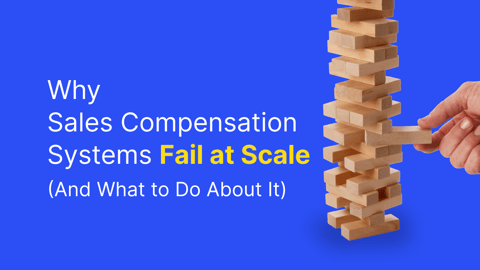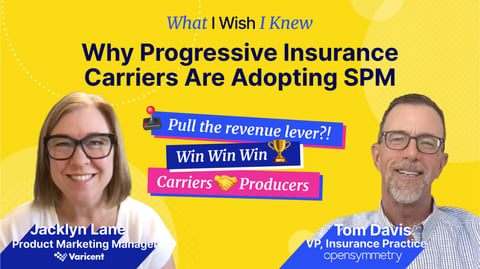Variable payment models for customer-focused employees are a tried and tested model for motivating them. They reward extra effort and commitment with additional rewards, and are a great way to align the interests of salespeople with the broader business.
When planned well, On-Target Earnings (OTE)-based compensation models can be part of your secret sauce to drive business success and achieve your goals. Equally, a poorly planned or poorly executed OTE comp model can be a drag on your business, demotivating your sales team and increasing your sales employee turnover.
So, what issues do you need to consider to get it right? What’s the best way to implement your OTE comp model? How can technology best help you get the results you need?
Before we dive into all the detail and answer these vital questions, let’s explore how variable payment models can fit into your sales compensation plans.
- Why Does OTE Matter?
- Designing Your OTE Plan
- Designing the Ideal OTE Model
- Leveraging Technology to Develop the Ideal OTE Model
Why Does OTE Matter?
OTE-based incentive models are valued by managers, employees, and potential employees, primarily because they clarify what can be a confusing picture of the opportunity you offer.
There’s no point in a sales manager and a salesperson having different views of the potential opportunity in a territory. OTE models help them get the same view of the opportunity and the potential rewards a sales territory offers. It also helps potential salespeople understand what they would be signing up for if they joined your company.
OTE-based Models as Part of Your Sales Incentive Plan
Employee compensation models matter to senior company managers because they’re crucial to attracting and retaining the talent they need to achieve their commercial and operational goals.
While many staff will be on some bonus model to help foster focus and commitment, for salespeople, this issue matters even more because of the unique nature of their role.
Working in sales isn’t for the faint-hearted; it’s ideal for those seeking a challenge, even an adventure. Salespeople will typically be given significant autonomy in achieving their quota, engaging with their customers, and allocating their time.
This framework can give rise to the situation where a salesperson is distracted by activities that keep them busy but don’t help them achieve their quota. It’s easy to become distracted by ‘elephant hunting’ – finding that important but complex deal that may or may not blow their quota out of the water and establish them as one of the businesses’ ‘heavy hitters.’ Equally, it’s easy to be distracted by new prospects keen to buy but not ready to do so. Time spent on these prospects isn’t yet valuable; it may be better to follow up and re-engage with them in six months when they’re more prepared to buy.
On-Target Earnings plans are designed to help address these issues by incentivizing salespeople to look at their sales and opportunity pipeline dispassionately and focus on the opportunities that’ll close in the coming weeks and months rather than projects that pique their personal or professional interests.
Designing Your OTE Plan
In principle, designing your OTE plan should be straightforward. All you need to do is divide your company sales quota by the number of territories and develop an incentive package that the company can afford that gets you to your overall sales quota. Simple, right?
As any sales manager or HR professional will attest, the reality is more complex, fluid, and dynamic. There are plenty of potential pitfalls to trap the unwary. There are numerous variables that you need to think about when planning your OTE model.
Let’s explore them in more depth.
1. Base Salary
It may seem odd to think about the fixed component of a variable pay model, but it’s an essential element to consider for your OTE model to be effective.
In B2B sales, it’s normal for the sales compensation package to be a 50/50 mix of fixed and variable components. This reflects the complexity and duration of a B2B sales process, especially where there are multiple touchpoints in the sales campaign. The base salary element helps support the salesperson during the campaign, while the variable OTE component provides the incentive to see a sales campaign through to a successful conclusion.
Depending on the complexity of the sales process, the base salary component may decrease to a 30% fixed/70% variable mix, for example. In some cases, it’ll be exclusively variable with no base salary. These situations are more typical if the sales process is short and straightforward.
A low fixed salary/high variable reward model provides the ideal incentive to drive significant overperformance by salespeople. On the downside, it also rewards behavior that might impact customer satisfaction in the longer term, as the promises made during a high-pressure sales engagement might be unrealistic in the medium or longer term.
2. The Variable Component
The variable OTE element of a sales compensation model might seem cut and dried; the more you close, the more you earn.
But again, there’s much more here than meets the eye.
There are several options open to you. Do you pay a straight commission – e.g., 10% on every dollar sold, without limit? Or should you vary the commission rate based on quota achievement on the year to date? For example, you could pay 10% for everything below 75% but pay a 15% rate above 75% quota achievement and a 20% commission rate above 100% quota achievement. Equally, you might bias commission incentives, so transactions closed in the year's first half attract a better commission rate than those closed in the second half. It depends on how you want to build your business and develop your sales team.
Another question to consider is what revenues do you recognize in your OTE model? Not all revenue is the same – some revenue streams enjoy higher margins than others. For example, product revenues have the highest margins typically in a business. Whereas service revenues, whether training or implementation services, have higher costs, as dedicated teams typically deliver them.
3. Other Sales Incentives
While strictly speaking, falling outside an OTE incentive framework, there are other incentives a company might consider when seeking to attract and retain the type of employees they need to prosper.
This could involve additional benefits like health and medical coverage, gym memberships, or share incentive plans. Equally, different short-term incentive programs like additional bonuses or sales competitions can help staff remain motivated, engaged, and productive. These should be considered and managed as part of the broader sales incentive program that the OTE model is part of.
Designing the Ideal OTE Model
As we’ve already touched on, there’s more complexity than you might appreciate when designing your sales incentive plan. That isn’t to say it’s hugely complex, but there are more variables to consider when designing the ideal model. This matters, after all, as the key to a successful sales compensation model is aligning the individual interests of salespeople with the broader needs of the business.
A good plan maximizes the upside for employees while avoiding the pitfalls of a system that’s complex to navigate and works against the business.
Let’s explore some issues to consider.
Marketing Sizing & Territory Planning
It’s only possible to design an effective OTE incentive model by understanding the market opportunity and potential sales territory structure. We live in a commercial world where there are few second chances for companies, or executives, for that matter. Understanding the market opportunity and using that insight to create a suitable incentive model is valuable for any business. There’s little room for ‘inspired guesswork,’ ‘I’ve always done it this way,’ or ‘our competitors use this approach.’
The first step in creating the ideal OTE model is to go through a systematic market sizing exercise for your business or product. To do this, you need a solid understanding of your target customers or prospects.
You can then apply data analytics to a range of data sources – your own and 3rd party sources – to see where these customers are located, how many there are, how they make their decisions, and how they buy from you. This will give you a baseline to start your sales and marketing planning effectively and a fixed data point to monitor your progress and understand future market changes.
With a clear understanding of your addressable market, you can understand how best to divide your sales territories to help you achieve your objectives. Again, there’ll be a significant range of variables you’ll want to consider, and they’ll vary by company.
For example, how long is the sales cycle? If a sales cycle is relatively short – say a few days or weeks – then a territory can support a more significant number of accounts than one where the sales cycle is longer. Let’s consider a sales cycle that takes several months: Assuming the transaction value is significant, a territory will only support a small number of specific accounts, likely based around a sector-specific area, e.g., finance, retail, or energy.
With this framework laid out, you’ll be in a position to start developing the territory model that best suits your business. The ideal approach is to review various options to optimize your sales coverage, which might be affected by geography or the third-party relationships you can utilize as part of your go-to-market strategy.
Quota Planning
With your sales territories sorted out, you can start to look at your quota planning, which, not surprisingly, will get you to where you can finalize your OTE model.
Again, significant thought needs to be put into your quota planning.
At a fundamental level, it needs to be stretched but achievable. Otherwise, your sales team won’t ‘buy’ into the plan and will vote with their feet.
Sales managers need to consider a range of variables, including the business' revenue needs, the cost of sales and marketing support, the resources required to close, and whether revenue will come from new accounts, existing accounts, or both. Repeat maintenance and subscription revenues also need to be factored in since they’re often high-margin business lines that don’t need the same sales focus as new businesses.
Leveraging Technology to Develop the Ideal OTE Model
Even with this brief exploration, this approach can challenge many businesses’ management processes. While many see the value of a data analytics-led model, only some sales and marketing functions are blessed with the resources to undertake this type of work routinely.
However, modern SaaS-based sales analytics platforms can change all this. They can capture and consolidate large volumes of sales, customer, and industry data in one place, allowing managers to use AI capabilities to navigate all this data to understand and master the trends and dynamics of their target market. This can help them develop a model that supports marketing sizing, territory and quota planning, and ultimately designing the ideal OTE model.
Learn more about creating the ideal OTE model your business needs in our eBook that helps you create better compensation plans in 2023.



